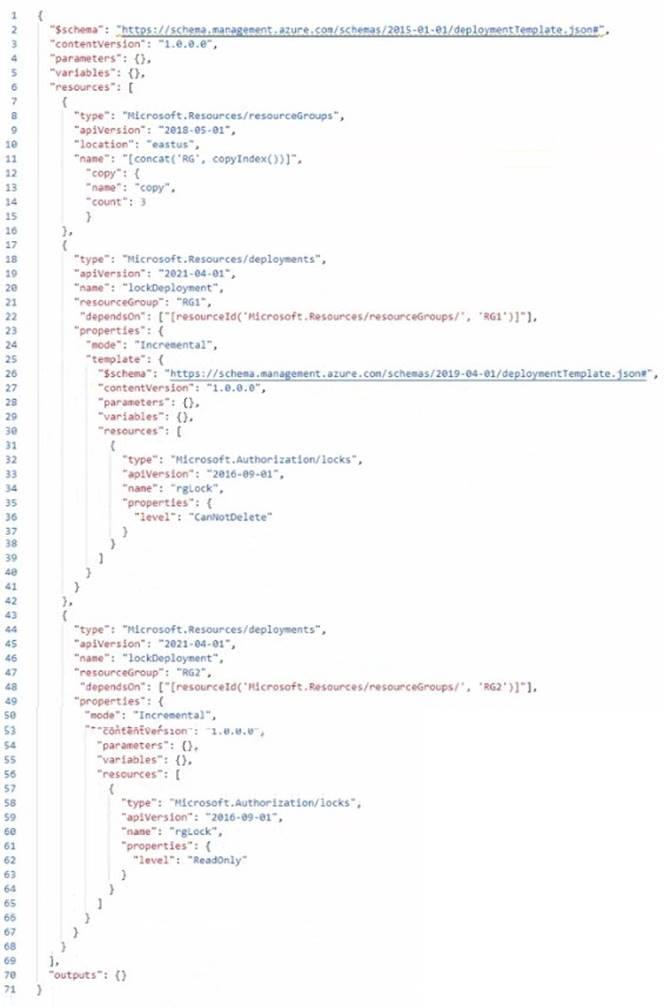- (Topic 5)
You have an Azure subscription that contains the storage accounts shown in the following table.
You need to identify which storage account can be converted to zone-redundant storage (ZRS) replication by requesting a live migration from Azure support.
What should you identify?
Correct Answer:
B
https://learn.microsoft.com/en-us/azure/storage/common/redundancy- migration?tabs=portal
HOTSPOT - (Topic 5)
Your company purchases a new Azure subscription.
You create a file named Deploy json as shown in the following exhibit

You connect to the subscription and run the following cmdlet:
New-AzDeployment -Location westus -TemplateFile “deploy.json”"
For each of the following statements, select Yes if the statement is true. Otherwise, select No.
No.
Solution:
Based on the file named Deploy.json and the cmdlet you ran, here are the answers to your statements:
✑ You can deploy a virtual machine to RGI. = No
✑ You can deploy a virtual machine to RG2. = No
✑ You can manually create a resource group named RG3. = Yes Let me explain why:
✑ The Deploy.json file defines a template for creating a resource group and a virtual machine in Azure. The template has two parameters: resourceGroupName and vmName. The template also has two resources: one for the resource group and one for the virtual machine. The resource group resource has a property called name, which is set to the value of the resourceGroupName parameter. The virtual machine resource has a property called location, which is set to the value of the location parameter of the deployment cmdlet.
✑ The cmdlet you ran specifies the location as westus and the template file as Deploy.json. However, it does not specify any values for the resourceGroupName and vmName parameters. Therefore, the cmdlet will prompt you to enter those values interactively before creating the deployment.
✑ If you enter RGI as the value for the resourceGroupName parameter and VM1 as the value for the vmName parameter, then the cmdlet will create a resource group named RGI and a virtual machine named VM1 in the westus location. Therefore, you can deploy a virtual machine to RGI.
✑ However, if you enter RG2 as the value for the resourceGroupName parameter, then the cmdlet will fail with an error. This is because RG2 already exists in your subscription and you cannot create a resource group with the same name as an existing one. Therefore, you cannot deploy a virtual machine to RG2 using this template and cmdlet.
✑ You can manually create a resource group named RG3 by using another cmdlet: New-AzResourceGroup. This cmdlet takes two parameters: Name and Location. For example, you can run the following cmdlet to create a resource group named RG3 in westus:
RG3 in westus:
New-AzResourceGroup -Name RG3 -Location westus
Does this meet the goal?
Correct Answer:
A
- (Topic 5)
You have an Azure subscription that contains a resource group named RG26.
RG26 is sot to the West Europe location and is used to create temporary resources for a project. RG26 contains the resources shown in the following table.
SQLD01 is backed up to RGV1.
When the project is complete, you attempt to delete RG26 from the Azure portal. The deletion fails.
You need to delete RG26. What should you do first?
Correct Answer:
A
You can't delete a vault that contains backup data. So in this case at first you have to delete the backup of 'SQLD01' before you attempt to delete the vault. Reference:
Reference:
https://docs.microsoft.com/en-us/azure/backup/backup-azure-delete-vault
HOTSPOT - (Topic 5)
You have an Azure Load Balancer named LB1.
You assign a user named User1 the roles shown in the following exhibit.

Solution:
User Access Administrator can only assign access to other users https://docs.microsoft.com/en-us/azure/role-based-access-control/rbac-and-directory- admin-roles
https://docs.microsoft.com/en-us/azure/role-based-access-control/rbac-and-directory- admin-roles
Virtual Machine Contributor can Manage VMs, which includes deleting VMs too. https://docs.microsoft.com/en-us/azure/role-based-access-control/built-in-roles#virtual-machine-contributor
https://docs.microsoft.com/en-us/answers/questions/350635/can-virtual-machine-contributor-create-vm.html
Does this meet the goal?
Correct Answer:
A
- (Topic 5)
You have an Azure Active Directory (Azure AD) tenant named contoso.com.
You have a CSV file that contains the names and email addresses of 500 external users. You need to create a guest user account in contoso.com for each of the 500 external users.
Solution: You create a Power Shell script that runs the New-MgUser cmdlet for each user. Does this meet the goal?
Correct Answer:
B
https://learn.microsoft.com/en-us/azure/active-directory/external-identities/tutorial-bulk-invite?source=recommendations

